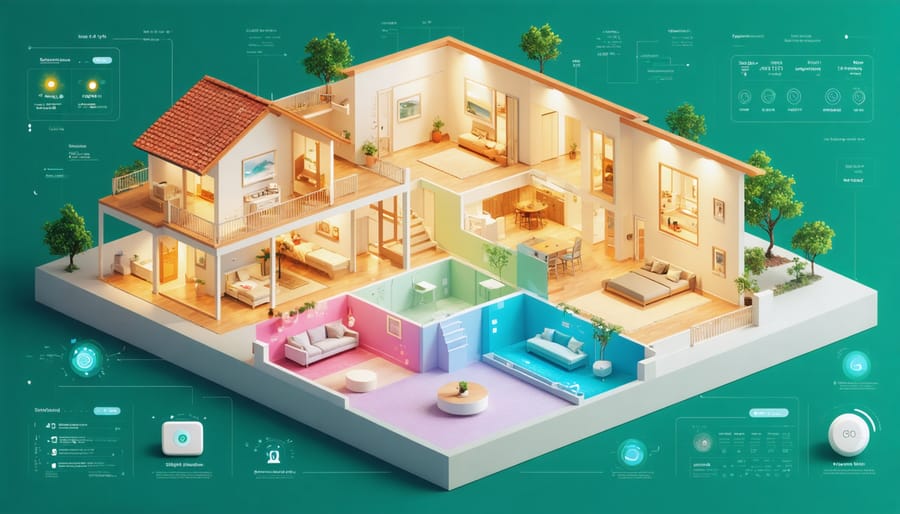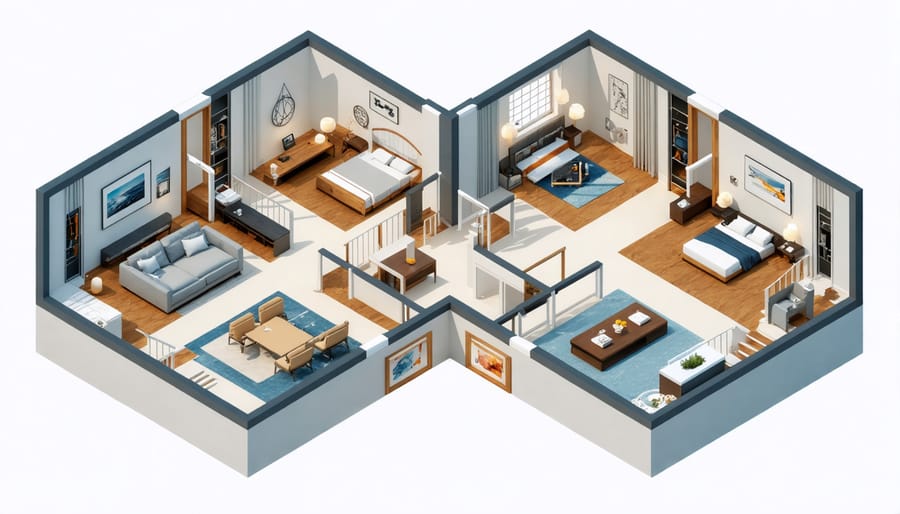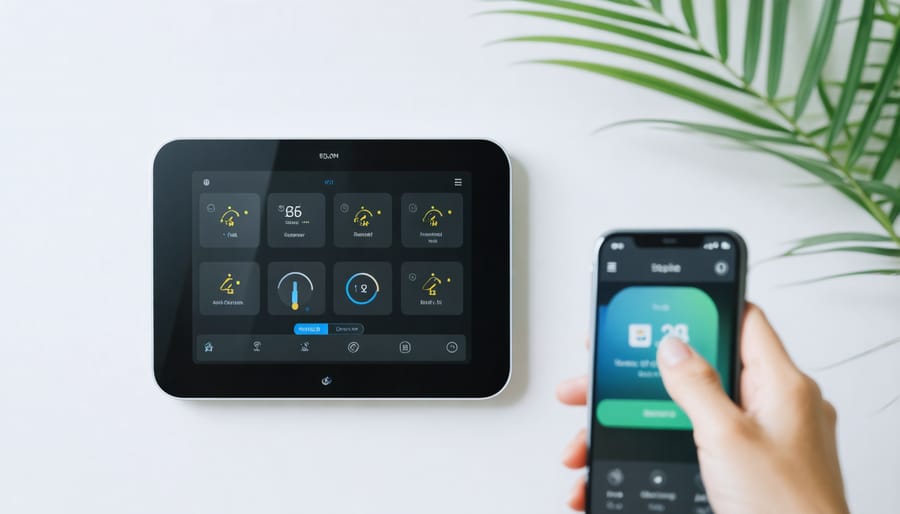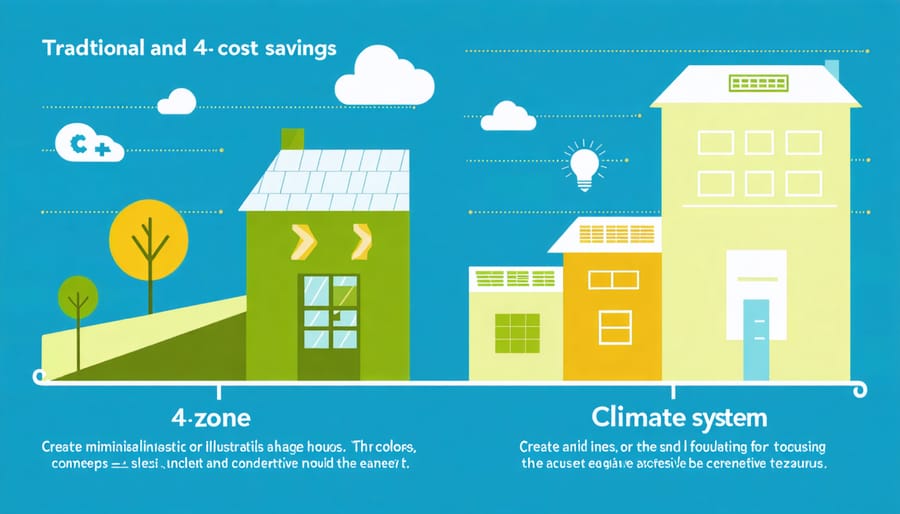
4-Zone Climate Control: The Smart Way to End Home Temperature Wars
Transform your home’s comfort with 4-zone climate control, the smart solution that lets you customize temperatures in different areas of your living space. Gone are the days of one-temperature-fits-all heating and cooling, replaced by precise control over individual zones – from keeping bedrooms cool at night to maintaining a warmer living room during the day. This innovative system not only enhances comfort but also slashes energy bills by up to 30% through targeted temperature management. Whether you’re dealing with a sun-drenched kitchen, a naturally cool basement, or different temperature preferences among family members, 4-zone climate control delivers personalized comfort while maximizing energy efficiency. Modern systems integrate seamlessly with smart home technology, allowing you to adjust temperatures from your smartphone or create automated schedules that adapt to your lifestyle – making comfort truly intelligent and effortless.
What Makes 4-Zone Climate Control Different?
The Technology Behind Zone Control
Modern 4-zone climate control systems rely on a sophisticated network of components working together seamlessly. At the heart of the system is a smart thermostat that serves as the command center, offering intuitive control over different zones through user-friendly interfaces and mobile apps. These advanced thermostats deliver smart HVAC control benefits while coordinating with other system components.
Motorized dampers installed within your ductwork act as intelligent gates, controlling airflow to each zone based on the thermostat’s commands. These dampers can open and close precisely, ensuring optimal air distribution throughout your home. Temperature sensors placed strategically in each zone continuously monitor conditions and communicate with the main thermostat, allowing for real-time adjustments.
The system also incorporates pressure sensors that maintain proper airflow balance, preventing strain on your HVAC equipment. When multiple zones are closed off, a bypass damper helps regulate air pressure throughout the system. This intelligent orchestration of components ensures each zone maintains its desired temperature while operating efficiently and extending the life of your HVAC system.
Understanding the Four Zones
A typical 4-zone climate control system divides your home into distinct areas that can be independently heated or cooled. The most common layout includes separate zones for the main living area, master bedroom, additional bedrooms, and basement or upper floor. Each zone operates with its own thermostat, allowing family members to customize temperatures to their preferences.
You can adjust these zones based on your home’s layout and usage patterns. For instance, you might group rarely-used guest rooms into one zone while giving frequently occupied spaces individual control. Some homeowners choose to separate their kitchen area, which tends to run warmer, from the dining room for more precise comfort management.
Modern systems also offer scheduling options, letting you set different temperatures for each zone based on time of day or occupancy patterns.

Smart Features That Make Life Easier
App Integration and Remote Control
Modern 4-zone climate control systems offer seamless smart home integration through dedicated smartphone apps and popular home automation platforms. Simply download your system’s official app to adjust temperatures, set schedules, and monitor each zone remotely. Most manufacturers provide intuitive interfaces that display real-time temperature readings and allow you to create custom climate profiles for different times of the day.
Compatible with major platforms like Apple HomeKit, Google Home, and Amazon Alexa, you can control your zones using voice commands or integrate them into broader automation routines. For example, set your bedroom zone to cool down automatically before bedtime, or have your living room warm up just before you arrive home from work.
Many apps also offer energy usage reports and smart suggestions to optimize your system’s efficiency. Some advanced features include geofencing, which automatically adjusts temperatures based on your location, and smart scheduling that learns your preferences over time.

Learning Algorithms and Scheduling
Modern 4-zone climate control systems use sophisticated learning algorithms to make your home more comfortable while maximizing energy efficiency. These smart systems track your temperature preferences throughout the day and automatically adjust settings based on your habits. For example, if you consistently lower the temperature in your bedroom at night, the system will learn this pattern and begin making these adjustments automatically.
The scheduling feature works hand-in-hand with the learning capabilities. You can set initial schedules for each zone, but the system will fine-tune these based on occupancy patterns and your manual adjustments. If you frequently override a scheduled temperature, the system will suggest updating your preset schedule to better match your preferences.
Many systems also factor in external conditions like weather forecasts and solar gain to optimize comfort levels. They can predict when to start heating or cooling to reach your desired temperature at the right time, rather than waiting until a scheduled moment. This predictive capability ensures each zone maintains ideal comfort while minimizing energy waste.
Installation and Setup Considerations
Professional vs. DIY Installation
While basic zoning modifications like closing vents or adjusting dampers can be DIY projects, installing a complete 4-zone climate control system typically requires professional expertise. Homeowners can handle simple tasks such as programming thermostats, maintaining filters, and ensuring proper airflow. However, the core installation involves complex ductwork modifications, electrical wiring, and HVAC system integration that should be left to certified professionals.
If you’re considering DIY installation, be aware that incorrect setup can lead to system inefficiency, increased energy costs, and potential damage to your HVAC equipment. Professional installers bring specialized knowledge about load calculations, zone sizing, and system compatibility. They also ensure your installation meets local building codes and manufacturer specifications.
The investment in professional installation often pays for itself through optimal system performance, proper warranty coverage, and peace of mind knowing your zoning system is correctly configured.
Compatibility with Existing Systems
Before installing a 4-zone climate control system, you’ll need to evaluate your existing HVAC setup. Most modern forced-air systems can be adapted for zoning, but there are a few key factors to consider. First, check if your current ductwork can accommodate dampers and zone controls. The main trunk lines should be accessible and have enough space for damper installation.
Your HVAC system’s capacity is another crucial consideration. The unit should be able to handle variable loads when different zones are active or inactive. Systems with variable-speed blowers are ideal, as they can adjust airflow based on demand. If you have a single-stage system, you may need to upgrade to a multi-stage or variable-speed unit for optimal zoning performance.
Don’t forget to assess your thermostat wiring. Most zoning systems require additional wiring to connect multiple thermostats and dampers to the main control panel. A professional HVAC assessment can help determine if your current setup is zone-ready or needs modifications.
Energy Savings and ROI
Installing a 4-zone climate control system can lead to significant energy savings and a compelling return on investment. Most homeowners report a 20-30% reduction in their heating and cooling costs after implementing these energy-saving solutions. This is because you’re no longer wastefully heating or cooling unused spaces, and each zone can be precisely maintained at its optimal temperature.
The initial investment typically ranges from $2,000 to $3,500, depending on your home’s size and existing HVAC setup. While this might seem substantial, the system usually pays for itself within 2-3 years through reduced energy bills. For a 2,500-square-foot home, many homeowners save $500-$800 annually, making it a smart long-term investment.
Beyond monetary savings, these systems also reduce your carbon footprint. By operating more efficiently and only when needed, they consume less energy and minimize environmental impact. The smart scheduling features further optimize energy usage by automatically adjusting temperatures based on your daily routines.
For maximum ROI, consider combining your zoned system with other efficiency upgrades like smart thermostats and regular maintenance. Many utility companies also offer rebates for installing energy-efficient HVAC systems, which can help offset the initial costs and accelerate your return on investment.

Four-zone climate control represents a significant leap forward in home comfort and energy efficiency. By allowing precise temperature control in different areas of your home, you’ll enjoy personalized comfort while potentially reducing your energy bills. Whether you’re looking to maintain different temperatures for various activities, accommodate multiple preferences, or simply optimize your home’s energy usage, a 4-zone system offers the flexibility and control you need. Take the next step toward enhanced comfort by consulting with a qualified HVAC professional who can assess your specific needs and help you design the perfect zoning solution for your space. Your comfort and satisfaction with your home environment are worth the investment in this smart, efficient technology.
